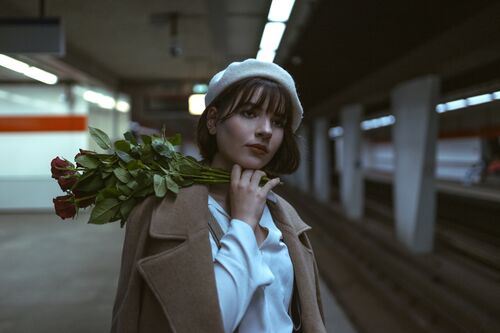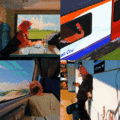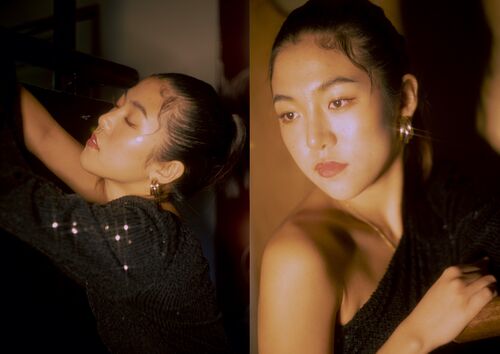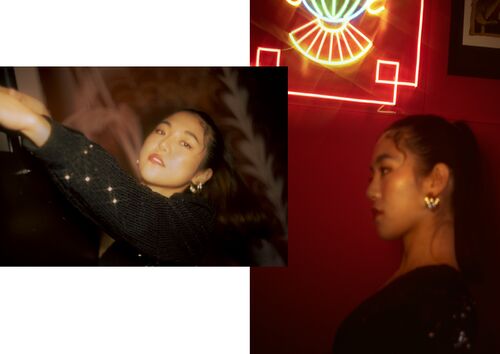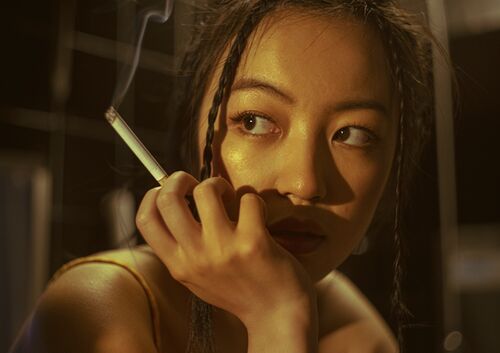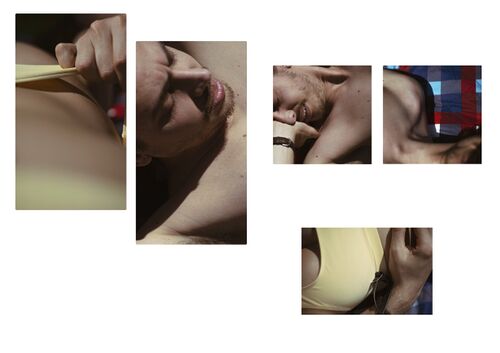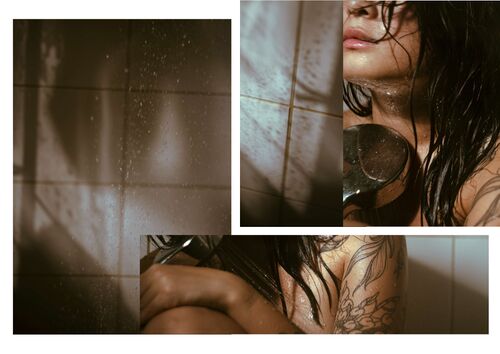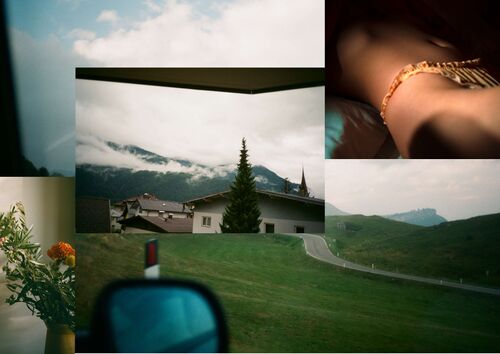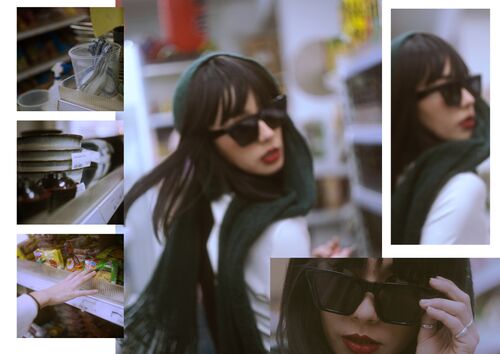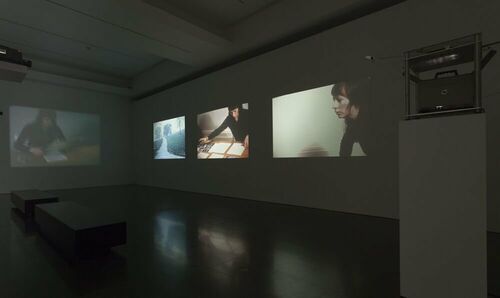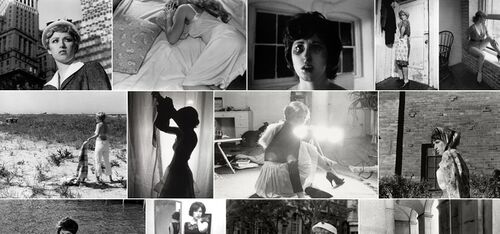MathildeThesisDraft
INTIMACY * EMOTIONS * MEMORIES
A study on slice of life photography and conveying nostalgia
Toward Slice of life works
In the previous work I did before joining PZ I’ve experimented a lot with creating cinematic scenes, almost like a screenshot out of a movie. These examples below were created with a scene in mind where the character in the story is either on their way somewhere or waiting for something. Back then I created the images with the ultimate goal of wanting to achieve this slice of life type of storytelling that is the goal of the thesis I am writing, however I felt that they lacked the narrative depth that I am currently in search of.
While these images are no longer representative of my current work and research, the underlying goal that I was trying to create is still an ongoing journey for me.
The dictionary definition of Slice of Life is: "a realistic representation of everyday experience in a film, play, or book." But what does it mean to me? To me slice of life work romanticises the mundane. I would see it as an analysis in which the work would highlight a "boring" scenario but find a way to highlight a certain beauty or calmness in that moment. Almost like a mindfulness practice of the photographer.
One of the first experiments that I did was an analysis on memory.
I wanted to recreate moments of intimacy that provoke and convey emotion. These works would, too, have a "slice of life" element to them; by which I mean, universally relatable, specific moments that we all share. This concept also touched on the subject of mindfulness; these memories would be shot and composed in the way that I remember them: in fragments and details of a moment that comprise a story. Like being transported back to that moment.
The example below is a good example of what the memories would look like. They are scenarios that are all part of a bigger journey. It is telling is how the character experiences her journey. It is a relatable moment with which we can empathise and almost transport ourselves into that scenario and how we would feel ourselves.
Before I started experimenting with the memories; I focussed on style. Using the vocabulary of photography and cinema I tried to establish what this changes in my narrative. What does lighting do to a certain mood of the photograph? What does composition do with the intensity of a scene? And what do colours tell us about a moment?
These images were greatly inspired by the style of the movie "In the Mood for Love" By Wong Kar wai. This film a particular colour range; a yellow-greenish, mostly warm toned aesthetic with a high contrast and yet a softness to it. I will also draw on the influence of asian analog photographers who use a similar aesthetic of this grainy, green toned, nostalgic aesthetic. With this style, I want these images to put the viewer in a particular nostalgic place.
These images were shot digitally and colour graded and lit to have an analogue and cinematic blend style. This promotes, to me, the best of both worlds; combining my digital shooting method with the style and nostalgia of an analog look. I want these photographs to have a feeling of being a quick snapshot while at the same time being a little too dreamy and stylised to create the feeling of it being a memory that is romanticised.
What These are images inspired greatly by the moody, analog type, Asian cinema style of the movie In the Mood for Love by Wong Kar Wai. The color palette of these images is very loyal to that of the inspiration, as well as the intense and warm lighting creating a dramatic shadow. The first four images are captured less as a movie scene and more like analog photos. The lighting is very direct as if an on camera flash was used. The last image with the cigarette is an image that has more of a film still feel to it. How The work is made with a digital camera attempting to imitate an analog camera. The lens used is an old Helios 44-2 as the colours on this lens are more dreamy than my Sony Zeiss lens. To achieve the dreamy almost imperfect analog feel in the above 4 images, I used a star filter as well as a pro mist filter in order to bloom out the images and give the highlights a bit more flare. In the last image I just used the Helios lens and a very warm sport without a soft box in order to imitate harsh kitchen lights. Why The style of “In the Mood" for Love has a very vintage look to them almost like being transported to the 80’s. The dark mood gives it a sad and melancholic feeling to it; almost like remembering a beautiful and bittersweet moment in your life. This is a style I wanted to achieve in my work, because it would communicate a melancholic feel to the memories. Taking this color palette and lighting and creating a photograph that looks analog, also gave it a feeling of taking a snapshot of a moment instead of watching a movie. It gives the illusion of having more interaction with the subject.
Then I moved on to the creation of the actual 'memories'.
I start with moments I have experienced; for example lying in bed with my partner. The photographs will be intimate compositions of details that fix in the memory, arranged in ways to create a narrative that conveys emotion. In this experiment I have taken several images and rearranged them to give them a narrative like above. [WHAT IS THIS NARRATIVE?] This is the foundation on which I build my project, exploring more within the realm of intimacy starting with myself as a way of warming up to these intimate compositions.
[DESCRIBE EXPERIMENTS AND DESCRIBE WHY YOU CHANGED YOUR MIND= FOR INSTANCE DESCRIBE WHAT HOW WHY (300) = WHAT DID YOU LEARN FROM IT? HOW DID YOU GROW(DEVELOP)]
I want to draw on the visual language of cinema, such as 80s Asian cinema.
[GO INTO MORE DETAIL ABOUT THIS GENRE AND GIVE EXAMPLES OF SPECIFIC FILMS- LOOK FOR TEXTS ABOUT THESE FILMS]
However I would also like to dabble in a more wholesome/summery colour palette like in the Ghibli examples in the section "Why do I want to make it" and in the movie Sideways, which has a more sunny/dreamy aesthetic to it (1).[UNPACK; HOW IS For the analog style photography I would like to reference a photographer Emma Wondra (2). [GIVE A BRIEF ACCOUNT OF WHO SHE IS AND WHAT SHE DOES; WHY DOES SHE INTEREST YOU]
Why do you want to make it?
I have always been moved by "slice of life" type images and artworks, there is something poetic about a piece of artwork that shows you a normal everyday scenario that you are not a part of and can still give that feeling of having been there. It gives me a feeling of now-ness while never actually having experienced that particular moment. Examples of these kinds of moments in the movies Totoro and Kiki's Delivery Service below, in which an absolutely mundane moment is captured, however I am transported to relaxing, stress free summer days.
Another big reason I want to create this type of art is because slice of life Anime was a big part of my escapism tactics in childhood. They were essentially a coping mechanism for my younger self to deal with an unstable environment by mentally transporting myself into different, more stress free and wholesome worlds where alternative scenarios played out.
Relation to a larger context
This project will be my contribution to the slice of life style art. Below some screenshots of the movie Minari, which is about a Korean family in America that struggles to life off of a new farm they just moved to. While it's not spectacular in the same way that action movies are, and even though not everyone suffers the exact same struggles as they do; there is still a relatability in the way that the family is trying to keep afloat together, while still finding small hopeful moments in each other.
I hope to create the same types of artworks where the viewer can have a relatability in my work that is entirely shaped by how their life experiences are. Essentially finding common ground, despite different pasts, presents and futures.
Who can help you and how?
Right now I have found some courses on Domestika that might be beneficial to the research I am doing:
- Self-Portrait as a Personal Diary by Daniella Benedetti
- Emotive Photography: Create Real, Up-close Images by Carol Peña
Other than that I've been asked some critical questions that I struggle with and can help me closer to my goal, like:
- What makes a photograph cross the line of being more a pretty photo?
- Is this project more about mindfulness rather than the theme I am building this proposal around?
- How do I train myself to speak more about my work with deeper layers?
- Can I create a poetic layering in images without literally layering them?
- What would happen if I make this project more hyper-personal to my experiences instead of making work that I would deem "universally relatable?"
- What would happen if I dive more into the source of the "why do I want to make this?" question? (Escapism)
As I have made more of these "memory" experiments, I found that I don't necessarily know if that is the direction I want to take exactly and narratively. I would like to continue with the style references and I am very interested in creating an experience close to these memories, but perhaps not exactly that way. By asking myself these questions above, I would like to see if my project takes me in a direction that I am connected to a little bit more. Having more tutorials during my process can potentially help me unlock the "answer" I am looking for a little more,
Possible Exhibition outcomes/experiments
As for the exhibition; I would like to create a space in which it feels like the audience is "thrown" into these artificial memories that I created. I want this to feel organic and almost whimsical, like walking into a fantasy world made of memories. Therefore, I would love to eventually experiment with the following scenarios:
- Projection on Cloth (1): This would be a room where the audience would walk through a maze of cloth with projections on them as cloth is organic and the movement of the material brings a whimsy to the experience. This cloth could be a wrinkled type of linen to show the fragmentation and imperfections recalled of memories.
- Fragmented projections (2): This would be one or several walls with fragmented images projected on them. They would be changing constantly like as if you're watching someone remember different memories at once.
- Hanging polaroids (3): This installation would be comprised of lots of printed photos on thread. The audience would be walking in between them as if overwhelmed by all the life experiences and memories.
Within these installations I would be experimenting with music and lighting but do not yet know what particular lighting and music I would use as of yet and is a question I will be answering during my experiment.
Timetable
Oct-dec
- Make LOTS of prototypes, experiment all day, every day; experiment with narrative devices, find out what works and what doesn't; try out different display possibilities
- Shoot with models - main focus on developing analog style, composition experiments. Try to have a shoot every other week with the models, hoping to get more of a knack to storytelling compositions and will experiment with crops of the images in combination with each other.
- My own intimate moments - Main focus on composition.
Jan-Feb
- Shoots with models - Combine composition and style
- Start really experimenting with display possibilities
Feb-
- The work as a result of these experiments.
References/bibliography
Films
- In the Mood for Love Wong Kar-wai (2000)
- Minari Lee Isaac Chung (2021)
- My Neighbour Totoro Hayao Miyazaki (1988)
- Kiki's Delivery Service Hayao Miyazaki (1989)
- Sideways Alexander Payne (2004)
I choose these movies as my references because some of them have a "slice of life" element to them. Scenic/cinematographic and story wise I feel like they can have a relatability to different types of people because they can be interpreted in your own way, while still having a concrete idea of what is happening.
Art
*Film Script (Manipulation of Meaning)(1972) David Lamelas (1)
David Lamelas creates a "film" by projecting a series of cinematic photography slides (almost like film stills) next to each other. This relates to my project as my goal is to also create a scene by using a combination of photographs.
*Untitled Film Stills (1977-1980) Cindy Sherman (2)
In this series Cindy Sherman created self portraits in which she creates distinguished cinematic film stills. In Cindy Sherman - Untitled Film Stills, 1977-1980 Josephine Van de Walle writes: "Cindy Sherman played with the slipperiness of identity. In Untitled Film Stills, but also in all her later series, it is always Sherman herself who is in front of the camera. Yet these images are never really self-portraits. Sherman uses photography as a tool to deceive, and evades her own personality by taking on different identities." [1] This relates to my project as I am creating artificial memories and scenes that have a genuine quality to them, while at the same time being mostly, if not completely, staged.
Texts
- The Power of Now - Echkart Tolle " => [The book] presents itself as a discussion about how people interact with themselves and others. The concept of self reflection and presence in the moment."
- Once More... with Feeling: Reenactment in Contemporary Art and Culture, Robert Blackson, Art Journal Vol. 66, No. 1 (Spring, 2007), pp. 28-40 [<<you can get this text from jstor]
- ↑ Josephine Van de Walle, Modern Classics: Cindy Sherman - Untitled Film Stills, 1977-1980


